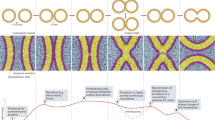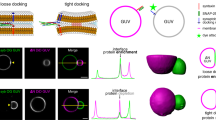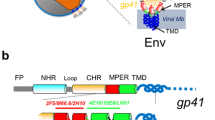Abstract
The question concerning whether all membranes fuse according to the same mechanism has yet to be answered satisfactorily. During fusion of model membranes or viruses, membranes dock, the outer membrane leaflets mix (termed hemifusion), and finally the fusion pore opens and the contents mix1,2. Viral fusion proteins consist of a membrane-disturbing ‘fusion peptide’ and a helical bundle that pin the membranes together2,3,4. Although SNARE (soluble N-ethylmaleimide-sensitive factor attachment protein receptor) complexes form helical bundles with similar topology, it is unknown whether SNARE-dependent fusion events on intracellular membranes proceed through a hemifusion state. Here we identify the first hemifusion state for SNARE-dependent fusion of native membranes, and place it into a sequence of molecular events: formation of helical bundles by SNAREs precedes hemifusion; further progression to pore opening requires additional peptides. Thus, SNARE-dependent fusion may proceed along the same pathway as viral fusion: both use a docking mechanism via helical bundles5,6 and additional peptides to destabilize the membrane and efficiently induce lipid mixing7,8,9. Our results suggest that a common lipidic intermediate3 may underlie all fusion reactions of lipid bilayers.
This is a preview of subscription content, access via your institution
Access options
Subscribe to this journal
Receive 51 print issues and online access
$199.00 per year
only $3.90 per issue
Buy this article
- Purchase on Springer Link
- Instant access to full article PDF
Prices may be subject to local taxes which are calculated during checkout





Similar content being viewed by others
References
Zimmerberg, J. & Chernomordik, L. V. Membrane fusion. Adv. Drug Deliv. Rev. 38, 197–205 (1999)
Cohen, F. S. & Melikyan, G. B. The energetics of membrane fusion from binding, through hemifusion, pore formation, and pore enlargement. J. Membr. Biol. 199, 1–14 (2004)
Chernomordik, L. V. & Kozlov, M. M. Protein-lipid interplay in fusion and fission of biological membranes. Annu. Rev. Biochem. 72, 175–207 (2003)
Tamm, L. K., Han, X., Li, Y. & Lai, A. L. Structure and function of membrane fusion peptides. Biopolymers 66, 249–260 (2002)
Eckert, D. M. & Kim, P. S. Mechanisms of viral membrane fusion and its inhibition. Annu. Rev. Biochem. 70, 777–810 (2001)
Sutton, R. B., Fasshauer, D., Jahn, R. & Brunger, A. T. Crystal structure of a SNARE complex involved in synaptic exocytosis at 2.4 Å resolution. Nature 395, 347–353 (1998)
Han, X., Bushweller, J. H., Cafiso, D. S. & Tamm, L. K. Membrane structure and fusion-triggering conformational change of the fusion domain from influenza hemagglutinin. Nature Struct. Biol. 8, 715–720 (2001)
Qiao, H., Armstrong, R. T., Melikyan, G. B., Cohen, F. S. & White, J. M. A specific point mutant at position 1 of the influenza hemagglutinin fusion peptide displays a hemifusion phenotype. Mol. Biol. Cell 10, 2759–2769 (1999)
Tucker, W. C., Weber, T. & Chapman, E. R. Reconstitution of Ca2+-regulated membrane fusion by synaptotagmin and SNAREs. Science 304, 435–438 (2004)
Wickner, W. Yeast vacuoles and membrane fusion pathways. EMBO J. 21, 1241–1247 (2002)
Mayer, A., Wickner, W. & Haas, A. Sec18p (NSF)-driven release of Sec17p (α-SNAP) can precede docking and fusion of yeast vacuoles. Cell 85, 83–94 (1996)
Kaiser, C. A. & Schekman, R. Distinct sets of SEC genes govern transport vesicle formation and fusion early in the secretory pathway. Cell 61, 723–733 (1990)
Weber, T. et al. SNAREpins: minimal machinery for membrane fusion. Cell 92, 759–772 (1998)
Peters, C. & Mayer, A. Ca2+/calmodulin signals the completion of docking and triggers a late step of vacuole fusion. Nature 396, 575–580 (1998)
Merz, A. J. & Wickner, W. T. Trans-SNARE interactions elicit Ca2+ efflux from the yeast vacuole lumen. J. Cell Biol. 164, 195–206 (2004)
Bayer, M. J., Reese, C., Buhler, S., Peters, C. & Mayer, A. Vacuole membrane fusion: V0 functions after trans-SNARE pairing and is coupled to the Ca2+-releasing channel. J. Cell Biol. 162, 211–222 (2003)
Thorngren, N., Collins, K. M., Fratti, R. A., Wickner, W. & Merz, A. J. A soluble SNARE drives rapid docking, bypassing ATP and Sec17/18p for vacuole fusion. EMBO J. 23, 2765–2776 (2004)
Wang, Y. X., Kauffman, E. J., Duex, J. E. & Weisman, L. S. Fusion of docked membranes requires the armadillo repeat protein Vac8p. J. Biol. Chem. 276, 35133–35140 (2001)
Reese, C. & Mayer, A. The rate limiting step of vacuolar membrane fusion follows trans-SNARE pairing and lipid-mixing. J. Cell Biol. (submitted)
Peters, C. et al. Control of the terminal step of intracellular membrane fusion by protein phosphatase 1. Science 285, 1084–1087 (1999)
Peters, C. et al. Trans-complex formation by proteolipid channels in the terminal phase of membrane fusion. Nature 409, 581–588 (2001)
Wang, L., Seeley, E. S., Wickner, W. & Merz, A. J. Vacuole fusion at a ring of vertex docking sites leaves membrane fragments within the organelle. Cell 108, 357–369 (2002)
Vogel, S. S., Leikina, E. A. & Chernomordik, L. V. Lysophosphatidylcholine reversibly arrests exocytosis and viral fusion at a stage between triggering and membrane merger. J. Biol. Chem. 268, 25764–25768 (1993)
Hiesinger, P. R. et al. The v-ATPase V0 subunit a1 is required for a late step in synaptic vesicle exocytosis in Drosophila . Cell 121, 607–620 (2005)
Epand, R. M. Fusion peptides and the mechanism of viral fusion. Biochim. Biophys. Acta 1614, 116–121 (2003)
Ungermann, C., Sato, K. & Wickner, W. Defining the functions of trans-SNARE pairs. Nature 396, 543–548 (1998)
Coorssen, J. R. et al. Regulated secretion: SNARE density, vesicle fusion and calcium dependence. J. Cell Sci. 116, 2087–2097 (2003)
Szule, J. A. et al. Calcium-triggered membrane fusion proceeds independently of specific presynaptic proteins. J. Biol. Chem. 278, 24251–24254 (2003)
Lindau, M. & Almers, W. Structure and function of fusion pores in exocytosis and ectoplasmic membrane fusion. Curr. Opin. Cell Biol. 7, 509–517 (1995)
Zimmerberg, J. How can proteolipids be central players in membrane fusion? Trends Cell Biol. 11, 233–235 (2001)
Acknowledgements
We thank M. Reinhardt, A. Schmidt and V. Comte for assistance, and N. Garin and M. Allegrini for help with confocal microscopy. This work was supported by grants from DFG, FNS, HFSP and Boehringer Ingelheim.
Author information
Authors and Affiliations
Corresponding author
Ethics declarations
Competing interests
Reprints and permissions information is available at npg.nature.com/reprintsandpermissions. The authors declare no competing financial interests.
Supplementary information
Supplementary Figure S1
Rhodamine-phosphatidylethanolamine (Rh-PE) incorporation into isolated vacuoles. (PDF 330 kb)
Supplementary Figure S2
GTPγS blocks maturation of pro-ALP that occurs by fusion. (PDF 75 kb)
Supplementary Figure S3
Confocal images of fusion of calcein-labelled vacuoles. (PDF 41 kb)
Supplementary Figure S4
Chemical structure of calcein, sulforhodamine B, and rhodamine-phosphatidylethanolamine (Rh-PE) (PDF 6 kb)
Supplementary Figure S5
Working model on the events in vacuole fusion. (PDF 7 kb)
Supplementary Figure Legends
This file contains the legends for the Supplementary Figures S1-S5. (DOC 22 kb)
Supplementary Data
Contains a detailed description and discussion of the establishment of the rhodamine-phosphatidylethanolamine based lipid-mixing assay. In a second part, control experiments concerning the inhibitory GTPγS effect on vacuolar membrane fusion are presented and discussed. Supplementary references are provided at the end of the document. (DOC 30 kb)
Supplementary Methods
Contains a description of reagents, strains used and methods not listed in the main text and Supplementary References. (DOC 32 kb)
Rights and permissions
About this article
Cite this article
Reese, C., Heise, F. & Mayer, A. Trans-SNARE pairing can precede a hemifusion intermediate in intracellular membrane fusion. Nature 436, 410–414 (2005). https://doi.org/10.1038/nature03722
Received:
Accepted:
Published:
Issue Date:
DOI: https://doi.org/10.1038/nature03722
This article is cited by
-
A tethering complex drives the terminal stage of SNARE-dependent membrane fusion
Nature (2017)
-
Organelle acidification negatively regulates vacuole membrane fusion in vivo
Scientific Reports (2016)
-
Membrane kiss mediates hormone secretion
Nature (2016)
-
The trans-SNARE-regulating function of Munc18-1 is essential to synaptic exocytosis
Nature Communications (2015)
Comments
By submitting a comment you agree to abide by our Terms and Community Guidelines. If you find something abusive or that does not comply with our terms or guidelines please flag it as inappropriate.



